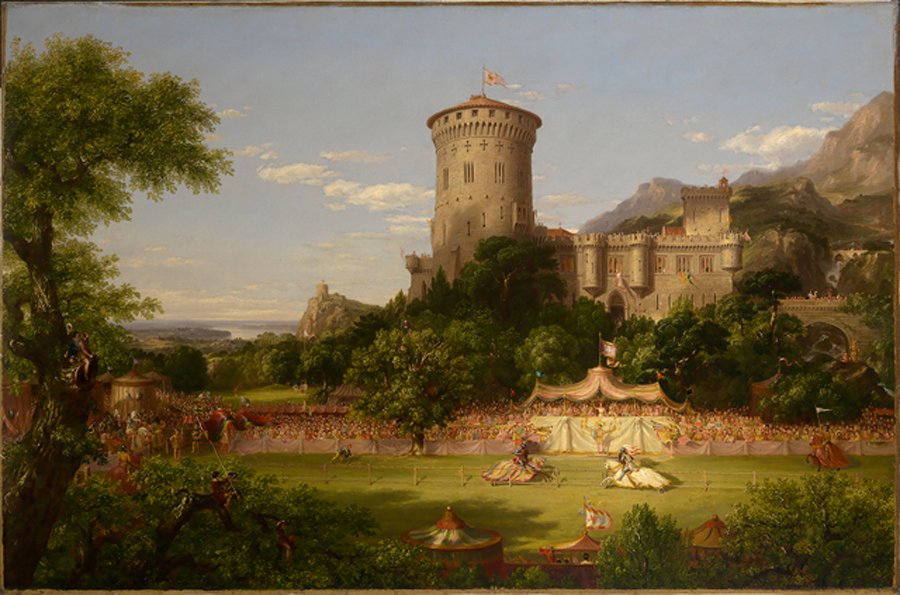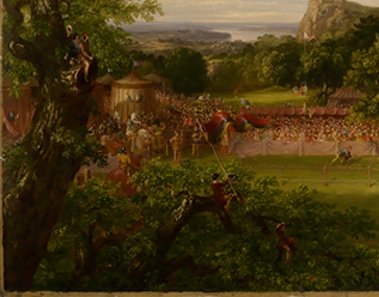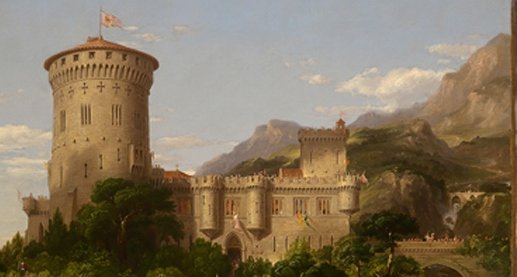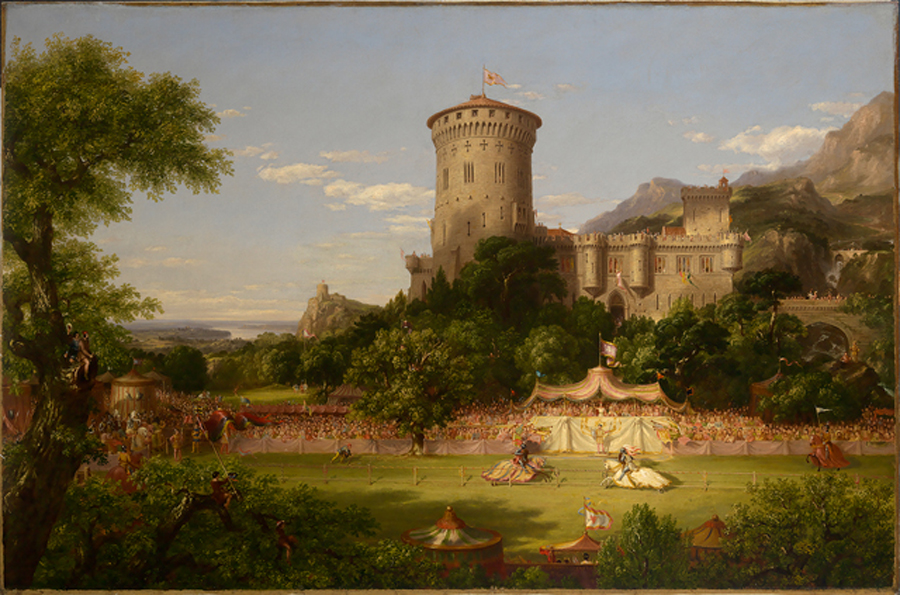Thomas Cole’s The Past (1838) has recently taken hold of my imagination in a big way. This cheerful depiction of a medieval tournament is one of several delightful Cole paintings I’ve discovered through my newest research project.

What is a tournament?
Practiced in western Europe from the 10th-16th centuries CE, tournaments featured warriors such as knights fighting mock battles to earn glory, win prizes, and show off their combat skills. These events were also entertainments filled with pageantry, feasting, and revelry, often to celebrate important occasions. Specifically, Cole’s painting depicts a joust, a tournament event in which knights tried to knock each other off their horses using long wooden lances. Some of you may be familiar with jousting through modern-day re-enactments. Most of these modern jousts aren’t strictly historically accurate, but I believe that they get the main ideas right.
Though set in the Middle Ages, this scene will feel familiar to anyone who has ever attended a modern sporting event. The contest is different, but the elements – athletes on the field, spectators in the stands, more athletes lining up on the sidelines, and participants warming up in the background – are much the same. In some ways, this scene could fit quite nicely into just about any time period. Also like in modern sports, there’s a strong sense of community; crowds have turned up to witness the event and cheer for their favorites. Colorful banners and circus-like tents enhance the festive tone.
The Past
Take a good look around, because there’s a lot going on in The Past. You can zoom in to see all the details at Google Arts & Culture. Like Cole’s famous The Course of the Empire series, this scene is heavily populated. Tiny little figures appear everywhere. They fill the stands and overflow down the lawn. Faces peek out of the castle’s every window, turret, and tower. (See detail 3.) People line the battlements and bridge. Some spectators have even climbed trees to get a better view! One man on the far left sits on a tree branch like it’s a horse, holding up a striped flag on a long pole. (See detail 1.) His pose parallels those of the two jousting knights, although they hold their lances horizontally rather than diagonally. Is the man in the tree is pretending to be part of the action, perhaps dreaming of competing in a future tournament?

In the foreground, three tents and the backs of a few ladies’ heads peek out from between the trees. Their inclusion breaks up the otherwise forward-facing, stage set-like composition. Charmingly, one of these tents flies a flag showing a heart pierced by an arrow. It alludes to the association between tournaments and chivalry or courtly love. Knights fought in part to gain attention from ladies, who would often give the combatants tokens of their support. Many women appear throughout the crowd, some in fabulous medieval-inspired head gear.
Most of the figures are little more than blobs of paint, but those in the first few rows have surprisingly individualized faces, clothing, and postures. For example, one man in the stands on the right rests his arms on the side of his box. The standing man at center is most prominent. (See detail 2.) Based on his placement and posture – he stands exactly below the apex of the largest tent and holds a staff – he seems to be the ruler of this imaginary kingdom. On either side of him, groups of figures sound long trumpets with colorful flags tied to them. One can easily imagine their trumpet calls urging the crowd to cheer louder, adding to the air of festivity.

The two jousting knights are depicted more precisely than most of the other figures, reflecting their importance to the event taking place. The knights and their horses are beautifully dressed. I especially like the horses’ flowing garments and the fancy plumes streaming behind the knights’ helms. The horse and rider on the right wear cream and gold, matching the hanging in from of the stands, the ruler’s garment, and the flag flying from the top of the castle. Does this make them the home team? Cole used this same gold lion on a cream flag in some of his other medieval-themed paintings.
To the left of the jousting pair, a small figure picking up broken lances reminds me of a peasant from a Bruegel painting. (He’s visible in detail 1.) He adds a nice, little comic touch to the scene. After using up three lances, which were designed to break when they made contact with an opponent, contestants would often switch to hand-to-hand combat if neither had yet been defeated. The man standing on the field in front of the stands prepares to equip one of the knights with a sword and shield. (See detail 1.) Other knights wait on the sidelines at left, and there’s another one on the field at right.
The Castle

While the painting’s inhabitants focus on the action, my attention gravitates to the castle. The Past‘s castle is attractive and impressive without being ornate. Its massive, round tower dominates the structure, echoed by several, smaller turrets. The main building is a solid, sturdy square with a square tower at the back. The building has small, beautifully-depicted stained glass windows, but aside from that, the castle looks believably defensible. After all, real medieval castles were fortresses, not secular Gothic cathedrals as we like to imagine them today. This muscular structure’s small windows, crenellations (the iconic tab shapes along the roof line), and cross or slit-shaped cutouts for archers fire through all fit with what I know about medieval castle architecture. While this castle wasn’t based on any particular building, lots of similar structures appear in Cole’s sketches from his European voyages.
Why I care
This painting excites me because it combines my two favorite topics – medieval art and American art. I want to understand more about Americans’ relationships to European medieval culture, which seems simultaneously so close and yet so far away to us. Artworks like The Past seem like perfect windows into this fascinating topic.
Thomas Cole’s The Past presents a medieval tournament as imagined by a 19th-century American artist. Cole painted this and a few similar works at the beginning of the Gothic Revival movement in the first half of the 19th century. As many of you may know, the Gothic Revival reflected its own time as much as (or even more than) the medieval past. It gave us the romantic, glamorous, mysterious Middle Ages that we wanted, rather than reconstructing that actually took place. And we’ve been doing much the same thing in art, literature, architecture, film, and popular culture ever since.
Here in the 21st century, we may have much more genuine, scholarly knowledge about the Middle Ages than Cole did in his day, but we’re still interpreting the time period to suit our own preferences. And why not? It’s fun and harmless, as long as we realize that we are viewing things through intentionally-distorted lenses. Although it was painted almost two hundred years ago, Cole’s joust resembles any number of recent re-imaginings of medieval tournaments, such as those at Renaissance Faires, on television, or in the movies. For example, the tournament scenes in the BBC series Merlin look almost exactly like this, complete with a gorgeous castle (the Chateau de Pierrefonds) in the background. The study of modern pop-culture interpretations of the medieval world is called Public Medievalism, and it’s my new favorite thing.
The Present

The Past has a companion painting, called The Present, which depicts the same site and castle as an abandoned, overgrown ruin many years later. It’s pretty, but rather sad, and I don’t like it nearly as much as The Past. Cole painted The Past and The Present on commission for Peter G. Stuyvesant, who ordered them based on the success of Cole’s earlier medieval landscapes, The Departure and The Return. As I continue to explore the Middle Ages in American art, look for some thoughts on those two beautiful and poetic paintings as well.
Sources:
- “The Past“. Five Colleges and Historic Deerfield Museum Consortium.
- Cartwright, Mark. “Jousting.” Ancient History Encyclopedia. Last modified July 02, 2018.
- Cartwright, Mark. “Medieval Tournament.” Ancient History Encyclopedia. Last modified May 07, 2018.
- Parry III, Ellwood C. “Gothic Elegies for an American Audience: Thomas Cole’s Repackaging of Imported Ideas”. In The American Art Journal, Vol. 8, No. 2 (Nov. 1976). P. 26-46.


